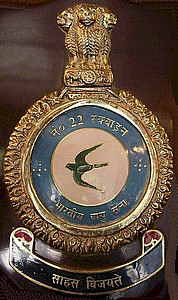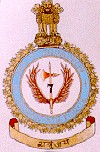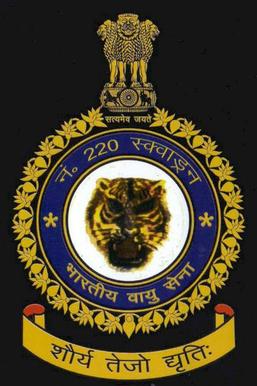
The Indian Air Force (IAF) is the air arm of the Indian Armed Forces. Its primary mission is to secure Indian airspace and to conduct aerial warfare during armed conflicts. It was officially established on 8 October 1932 as an auxiliary air force of the British Empire which honoured India's aviation service during World War II with the prefix Royal. After India gained independence from United Kingdom in 1947, the name Royal Indian Air Force was kept and served in the name of the Dominion of India. With the transition to a republic in 1950, the prefix Royal was removed.

Air Chief Marshal Pratap Chandra Lal, DFC was the Chief of Air Staff (CAS) of the Indian Air Force (IAF) during the Indo-Pakistani War of 1971. He served in the IAF from 1939 until his retirement in 1973. He was the CAS at the time of Operation Chengiz Khan, the preemptive strikes that were carried out by the Pakistan Air Force (PAF) that marked the formal initiation of hostilities of the war.

No. 22 Squadron (Swifts) was a CAS unit based out of Hasimara AFS. Along with No. 222 Squadron IAF Tiger Sharks, No. 22 Squadron forms a part of the 16 Wing of the IAF. The squadron operated MiG-27 till December 2017 and the squadron number-plated since then.

No. 7 Squadron, Indian Air Force operates as a Special Munitions Delivery and air superiority unit. Based at Gwalior AFB, No.7 Squadron forms a part of 40 Wing AF, Central Air Command.
The Eastern Air Command is one of the five operational commands of the Indian Air Force. Currently headquartered in Shillong in Meghalaya. Named No. 1 Operational Group at the time of its inception, 27 May 1958, it was based at Ranikutir in Kolkata as a part of the Govt's increasing emphasis on defence of the eastern borders. The Operational Group was upgraded as Command on 1 December 1959 with headquarters at Fort William, Kolkata and Air Vice Marshal KL Sondhi as the first AOC-in-C of the Eastern Command. After the 1962 Indo-Chinese War, The decision was made to raise a full-fledged command at Shillong. The area of responsibility of the command now covers 11 states, and is bound by the international boundaries of Nepal, Bhutan, China, Myanmar and Bangladesh incorporating 6300 km of common border. Eastern Air Command now has permanent airbases at Chabua, Guwahati, Bagdogra, Barrackpore, Hasimara, Jorhat, Kalaikunda and Tezpur with forward airbases at Agartala, Kolkata, Panagarh and Shillong. Eastern Air Command consists of Air Defence squadrons consisting of the MiG-21 and Ground attack squadrons consisting of the MiG-27. It holds the motto "Samareshu Parakramaha",
The No.3 Squadron (Cobras) of the Indian Air Force (IAF) operates as a Close Air Support (CAS) and reconnaissance unit. Currently based at NAL Air Force Station, No. 3 Sqn falls under the Western Air Command, forms the 46 wing of the IAF.
The Ambala Air Force Station is an Air Force base situated north of the urban Ambala Cantt area in Haryana, India. The Ambala Air Force Station is the home to the first batch of advance multirole fighter jet Dassault Rafales that have been inducted to Indian Air Force.

During the Indo-Pakistani war of 1965, the Indian and Pakistani Air Forces engaged in large-scale aerial combat for the first time. In the air war, which took place in September, both air forces conducted thousands of defensive and offensive sorties over Indian and Pakistani airspace. Both India and Pakistan claimed victory in the air war; Pakistan claimed to have destroyed 104 Indian aircraft and lost 19, and India claimed to have destroyed 73 Pakistani aircraft and lost 35 of its own. The air war ended in a stalemate.

No. 21 Squadron IAF (Ankush), is an Air Defence and Ground Attack unit of the Indian Air Force, operating from Sirsa AFS, as part of 12 Wing of Western Air Command. The squadron was number plated on an unspecified date.
No. 26 Squadron IAF (Warriors) is a Ground Attack and Close Air Support unit of the Indian Air Force, operating from Pathankot Air Force Station under India's Western Air Command. The squadron was number plated on an unspecified date.
Air Marshal Cheppudira Devaiah Subbaiah is a former pilot and officer in the Indian Air Force.
No. 106 Squadron ("Lynxes") is a squadron of the Indian Air Force. It was raised on 1 May 1957 with eight newly inducted PR.57 English Electric Canberras in the strategic photo-reconnaissance role. Initially positioned at Bareilly, later the squadron moved to Agra. When the Canberras were retired in 2007, the squadron was equipped with Hawker Siddeley HS 748 ("Avros"). The motto of the squadron is "Sarva Peshayami".

No. 17 Squadron is a squadron of the Indian Air Force stationed at the Ambala Air Force Station as part of the Western Air Command. The squadron was number-plated in 2016, but was resurrected in Ambala on 11 September 2019 with the Dassault Rafale.
No. 32 Squadron (Thunderbirds) is a fighter squadron of Indian Air Force. It was equipped with Mikoyan-Gurevich MiG-21Bison and was based at Jodhpur Air Force Station as part of South Western Air Command. The squadron was number plated in December 2016.

No. 220 Squadron is a fighter squadron and is equipped with Su-30 MKIs and based at Halwara Air Force Station.
Hasimara Air Force Station is an Indian Air Force (IAF) base located in Alipurduar district, West Bengal, India. Hasimara is located strategically near the Indo-Bhutan border. It is also the closest Indian air base to the Chumbi Valley - the tri-junction between the Indian state of Sikkim, Bhutan and the Tibet Autonomous Region.

No. 45 Squadron Indian Air Force is a Fighter Squadron internally based at Sulur AFS, Tamil Nadu. The squadron operates the indigenous HAL Tejas fighter from 1 July 2016. The squadron was initially based at Bangalore, Karnataka and later shifted to its main base in Sulur from 1 June 2018.

Air Chief Marshal Rakesh Kumar Singh Bhadauria, is a retired Indian Air Force officer, who served as the Chief of the Air Staff of the Indian Air Force, having assumed office on 30 September 2019 after the retirement of Air Chief Marshal Birender Singh Dhanoa. He retired on 30 September 2021 and was succeeded by Air Chief Marshal Vivek Ram Chaudhari.

Air Chief Marshal Vivek Ram Chaudhari, is an air officer of the Indian Air Force. He currently serves as the Chief of the Air Staff (CAS). He took over as the 24th CAS succeeding Air Chief Marshal Rakesh Kumar Singh Bhadauria on 30 September 2021. He earlier served as the 45th Vice Chief of the Air Staff and as the Air Officer Commanding-in-Chief Western Air Command.













